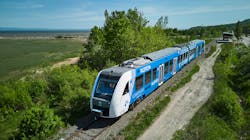On June 17, 100 passengers boarded the Coradia iLint for the first hydrogen train journey ever in North America. The train connected the Parc de la Chute-Montmorency in Quebec City to Baie-Saint-Paul, a 90-kilometer (55.9 mile) trip along the St. Lawrence River. The Coradia iLint, which generates its own energy using fuel cells supplied by Accelera by Cummins, which has operations in Ontario, is powered by green hydrogen produced by Harnois Énergies at its Quebec City site.
The project will allow Alstom and its partners to better assess the steps required in the process for the development of an ecosystem of hydrogen propulsion technology and its penetration into the North American market.
A first in Canada and in the Americas, Alstom and its partners: the government of Quebec, Chemin de fer Charlevoix, Train de Charlevoix, Harnois Énergies, HTEC and Accelera by Cummins to make this all happen.
The train will operate commercially in summer 2023 on the Réseau de Charlevoix railway network.
"Hydrogen technology offers an alternative to diesel and demonstrates our ability to provide more sustainable mobility solutions to our customers, agencies and operators, as well as passengers. said Alstom President of the Americas Region Michael Keroullé. "It will also provide an extraordinary showcase for Quebec’s green hydrogen ecosystem, which is under development.”
The province of Quebec will be the first jurisdiction to run a train with zero direct emissions powered by green hydrogen, demonstrating its leadership in the transition to a low-carbon economy and the set-up of ecosystems dedicated to hydrogen. The Hydrogen Research Institute of the Université du Québec à Trois-Rivières will accompany Alstom in the analysis of the results of this demonstration project.
The Coradia iLint first entered commercial service in Germany in 2018 and has travelled more than 220,000 kilometers (136,701 miles) in eight European countries. Currently, Coradia iLint is operating in commercial service on two different networks in Germany. The train is powered by a hydrogen fuel cell that emits only water vapor during operation while ensuring a quieter environment for passengers and those close to tracks.
On Sept. 15, 2022, the Coradia iLint travelled the record distance of 1,175 kilometers (730 miles) without refueling. Coradia iLint has a top speed of 140 km/h and acceleration and a braking performance comparable to a standard regional diesel train – but without the noise and the emissions. Coradia iLint stands out for its combination of innovative features: clean energy conversion, flexible energy storage in batteries, smart traction and energy management. Designed especially for non-electrified lines, it allows for safe, clean and sustainable operations. To date, 41 trainsets have been ordered by clients in Europe.
“We are proud to see our Coradia iLint hydrogen train onboard and carry its first North American passengers here in Quebec,” Keroullé said. “Alstom is fully involved in the decarbonization of mobility in the world and particularly in America. Hydrogen technology offers an alternative to diesel and demonstrates our ability to provide more sustainable mobility solutions to our customers, agencies and operators, as well as passengers. It will also provide an extraordinary showcase for Quebec’s green hydrogen ecosystem, which is under development.”
“Harnois Énergies is a partner in this project, positioning itself not only as a hydrogen producer, but also as a distributor," said Serge Harnois, president and CEO of Harnois Énergies. "The hydrogen used will be produced at our Quebec City station and will then be transported via high-pressure tanks to Baie St-Paul. Harnois Énergies is focused on the future and keeps an open mind. Energy diversification is at the heart of the company’s priorities,”
The Coradia iLint in Quebec is the first milestone in the development of an ecosystem around Alstom’s rail solutions with zero direct emissions. The primary mission of this center, located in Saint-Bruno-de-Montarville, Quebec, is the development of future platforms with hybrid, battery or green hydrogen propulsion specifically adapted to the North American market, leveraging the proximity to the more than 700 Alstom engineers currently working in the city to help accelerate the decarbonization of the rail sector.



